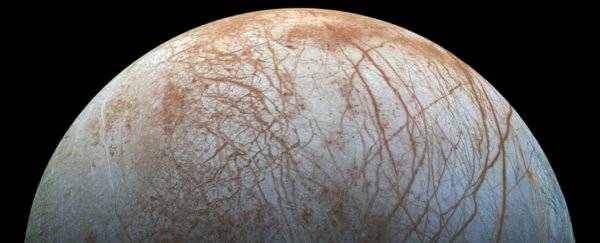New research into the mysterious rusty 'scratches' on the surface of Jupiter's moon Europa could be evidence for subsurface salt water - whole oceans of it - and the possibility of life, a team from NASA's Jet Propulsion Laboratory (JPL) in the US suggests.
By recreating exactly a patch of Europa's surface in a lab, JPL scientists Kevin Hand and Robert Carlson were able to show that the presence of salt, exposed to radiation near the surface, could be the reason for the yellowish-brown colour seen within the youngest regions of the moon's surface. "If it's just salt from the ocean below, that would be a simple and elegant solution for what the dark, mysterious matter is," Hand said in a press release.
Samples of common salt - or sodium chloride - along with mixtures of salt and water were tested in a special vacuum chamber simulating Europa's chilly surface temperature of -173 degrees Celsius, then bombarded with an electron beam to simulate radiation. After hours of exposure, Hand and Carlson discovered a chemical fingerprint matching features on Europa's surface and increasing the likelihood that the moon harbours a vast subsurface ocean of sea salt.
Scientists have been working for decades to crack the secrets below Europa's icy surface, focusing in recent years on the dark material coating some of the moon's geological features. Although data from flybys by the Galileo spacecraft accounted for some of the colours on Europa, the new studies fill in the gaps to paint a more precise picture, said Hand. "This work tells us the chemical signature of radiation-baked sodium chloride is a compelling match to spacecraft data for Europa's mysterious material," he said.
 Exposure to Europa-like conditions turned sodium chloride samples a yellowish-brown colour, just like that of dark streaks on the moon's surface. Credit: NASA/JPL-Caltech
Exposure to Europa-like conditions turned sodium chloride samples a yellowish-brown colour, just like that of dark streaks on the moon's surface. Credit: NASA/JPL-Caltech
One of the most important and difficult questions for scientists has been whether there is life on Europa. A first step toward answering that question is figuring out whether its ice-encrusted ocean could sustain life. Just last year, the JPL team discovered a population of tiny shrimp thriving in one of the world's deepest undersea hydrothermal vents, 5 km below the surface of the Caribbean Sea, which points to the possibility of life in similar environments on Europa or other planetary bodies.
Videos and samples retrieved by a submersible robot vehicle dubbed 'Jason' are now being studied at JPL, and have revealed "layer upon layer" of microscopic shrimp thriving near undersea vents spewing hot salt water. "For two-thirds of the Earth's history, life has existed only as microbial life," says Max Coleman, senior researcher at JPL. "On Europa, the best chance for life would be microbial."
